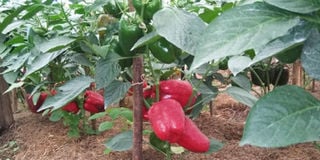Tips for growing green pepper

Farmers must harvest the green pepper early to avoid pest infestation. FILE PHOTO
Green pepper also known as capsicum is a common crop that does well in hot or warm areas such as eastern and central Uganda.
It’s one of the most important high value vegetable crops cultivated in the greenhouse, under shade or outdoor.
It is a source of vitamins A and C, with the red-coloured variety containing dietary fibre and is rich in antioxidants, which are essential in maintaining good health.
Varieties
Ideally, there are different varieties of capsicum, which start primarily as green but upon ripening, they end up as yellow, red or remain green.
Capsicum takes three to four months to mature, which makes it one of the best earning short-maturing crops.
Planting
The seeds are first sowed in the nursery and later transplanted. The germination of the seeds may be followed by a period of dormancy, taking 10-12 days before germinating depending on the variety.
The seedlings also have a relatively lower growth rate than other vegetables thus should take six to seven weeks in the nursery.
The nursery bed must be prepared to a fine tilth and the seeds sowed singly. Nursery management practices should be carried out effectively for one to produce healthy seedlings.
Best practices
These include adequate watering, weeding, pest and diseases management. The beds should be shaded to prevent the seedling from direct sunlight and strong wind.
Hardening off should be done a week before transplanting by reducing the frequency of watering gradually or removing the shade to prevent the seedlings from suffering transplanting shock. The land should be ploughed to a fine tilth a week before transplanting and well-decomposed manure added to the soil.
Transplanting is best done early in the morning or late in the evening. The spacing is determined by various factors such as irrigation layout, soil fertility.
However, the ideal spacing is 40cm by 60cm. Adequate watering should be done throughout the growing period for optimal production.
Inadequate water supply results to crop stress, wilting, flowers abortion and physiological disorders such as blossom end rot, which results to lower yields.
Sunscald is also a physiological disorder that affects capsicum as a result of exposure to excessive direct sunlight.
The fruit develops a whitish or necrotic area, which is on the side that is exposed to the sun leading to secondary infections by fungi.
The condition is most common in the open field unlike in the greenhouse, however, it can be managed by keeping the fruits shaded by crop leaves.
Field maintenance
Fluctuations in temperatures, high during the day and low at night, lead to purple stripping of the fruit. This affects quality.
This can be managed by ensuring that the soil is well-moist during the day, which creates a cooling effect on the plant.
The crop does well in well-drained fertile soils and can tolerate 5.5-6.5 pH levels. Fertiliser application should be made in line with soil analysis results.
However, over-fertilisation may result in fruits that are too large to meet the market demand.
Pests
Capsicum is attacked by several pests that not only damage the crop but also act as vectors for destructive diseases, especially the sucking insects. This include whiteflies, mites, aphids, nematodes and thrips.
Thrips attack will make the leaves to curl upwards, reducing in growth and hindering the absorption of nutrients. They also result to yield reduction and low market value.
Mites can be a problem, especially in hot, dry conditions. The young larvae and adults feed on the leaves and buds by sucking the sap, and unlike the thrips, they cause downward curling of the leaves. Whiteflies affect the crop by sucking the sap and releasing honeydew, which later turns to a black sooty substance preventing photosynthesis from taking place.
All these pests can be controlled by maintaining field hygiene, crop rotation, use of the sticky cards, for example, the yellow ones to control whiteflies while the blue to control the thrips.




